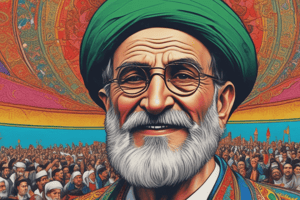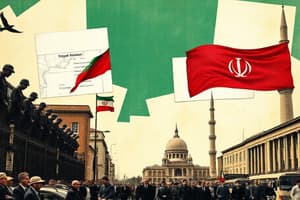Podcast
Questions and Answers
ما الذي انتقده آية الله الخميني في حكومة الشاه؟
ما الذي انتقده آية الله الخميني في حكومة الشاه؟
- اتهامات بالفساد والاحتيال (correct)
- الإجراءات الديمقراطية
- التطورات الاقتصادية
- الإنفاق على التعليم
ما الذي كان يعتبره آية الله الخميني في نظام الشاه غير إسلامي؟
ما الذي كان يعتبره آية الله الخميني في نظام الشاه غير إسلامي؟
- التطور الاقتصادي
- النهوض بقطاع التعليم
- النظام السياسي (correct)
- حكم الديمقراطية
ما هدف الثورة التي وقعت في إيران عام 1979 في بدايتها؟
ما هدف الثورة التي وقعت في إيران عام 1979 في بدايتها؟
- إقامة دولة إسلامية
- تحقيق التطور الديمقراطي
- القضاء على نظام قمعي (correct)
- الإصلاحات الاقتصادية
ما هو المبدأ الذي قامت عليه الجمهورية الإسلامية الجديدة في إيران؟
ما هو المبدأ الذي قامت عليه الجمهورية الإسلامية الجديدة في إيران؟
من المسؤول عن السلطة النهائية في إيران وفقًا للنظام الحكومي؟
من المسؤول عن السلطة النهائية في إيران وفقًا للنظام الحكومي؟
متى بدأت الاضطرابات في إيران؟
متى بدأت الاضطرابات في إيران؟
ما هي الطائفة الرئيسية في إيران؟
ما هي الطائفة الرئيسية في إيران؟
ما هو اسم الحزب الذي حل محل الأحزاب السياسية في إيران في عهد الشاه؟
ما هو اسم الحزب الذي حل محل الأحزاب السياسية في إيران في عهد الشاه؟
ما هو اسم الشرطة السرية التي استخدمها الشاه لقمع المعارضة؟
ما هو اسم الشرطة السرية التي استخدمها الشاه لقمع المعارضة؟
لمحاول مصدق تأميم أي صناعة في إيران؟
لمحاول مصدق تأميم أي صناعة في إيران؟
Flashcards are hidden until you start studying
Study Notes
- الثورة الإيرانية لعام 1979 تعتبر خطوة مهمة نحو إقامة دولة منعزلة ومتطرفة تدعم الإرهاب.
- الاضطرابات في إيران بدأت منذ القرون الوسطى، بحكم سلالات متعاقبة مثل سلالة القاجار والصفويون.
- الشيعة هم الطائفة الرئيسية في إيران، يعود تاريخهم إلى القرن السابع الميلادي.
- مصدق حاول تأميم صناعة النفط في إيران في عام 1951، لكن انتهى ذلك بانقلاب في عام 1953 بدعم من البريطانيين ووكالة المخابرات المركزية.
- الشاه رضا خان أصبح رضا شاه وحاول تحويل إيران إلى دولة علمانية على الطراز الغربي، ولكنه تعرض لانتقادات بسبب قمعه الديكتاتوري.
- في عام 1975، ألغى الشاه الأحزاب السياسية في إيران وأحل محلهم بحزب واحد، حزب الانبعاث.
- الشاه كان يستخدم شرطة سرية تسمى السافاك لقمع المعارضة، وكانت هناك اعتقالات وتعذيب للسجناء السياسيين.
- قبل الأحداث الدموية في عام 1975، شهدت إيران تحسينات اقتصادية واجتماعية كبيرة خلال فترة 1962-1975، خاصة في مجالات الصناعة والتعليم.- Oil revenues in Iran increased from $555 million in 1964 to $20 billion in 1976, under the rule of the Shah.
- The Shah government invested a significant portion of the oil money in infrastructure and education, leading to population growth, reduced child mortality rates, and the emergence of a new middle class.
- The Shah's White Revolution faced opposition, notably from the Shia cleric Ayatollah Khomeini, who criticized the reforms and accused the government of electoral fraud, constitutional violations, neglecting the poor, and selling oil to Israel.
- Khomeini viewed the Shah's regime as un-Islamic and led an uprising against it, initially driven by Iranians dissatisfied with the corrupt and unresponsive government.
- The 1979 revolution in Iran was not initially aimed at establishing an Islamic state but rather at overthrowing a perceived oppressive regime.
- Despite economic growth supported by oil revenues, many Iranians did not benefit economically, leading to unemployment and rural-urban migration.
- The revolution in 1979 began with peaceful protests that escalated due to government violence, leading to the collapse of the monarchy.
- The new Islamic Republic of Iran was established under Ayatollah Khomeini's principle of "Guardianship of the Jurist," giving a supreme religious scholar ultimate authority.
- The new Iranian government had elements of democracy, with elections for presidency and parliament, but the ultimate power rested with the Supreme Leader.
- The Islamic Republic's early days were marked by harsh measures to suppress opposition, including the establishment of the Islamic Revolutionary Guard Corps and Hezbollah, and a crackdown on dissent through revolutionary courts.
- Iran remains a complex system of governance where ultimate authority lies with the Supreme Leader, challenging Western perceptions of democracy in the country.
Studying That Suits You
Use AI to generate personalized quizzes and flashcards to suit your learning preferences.




